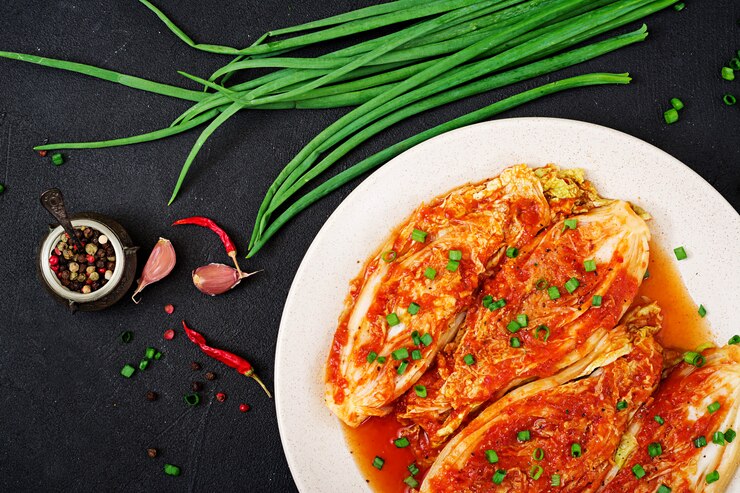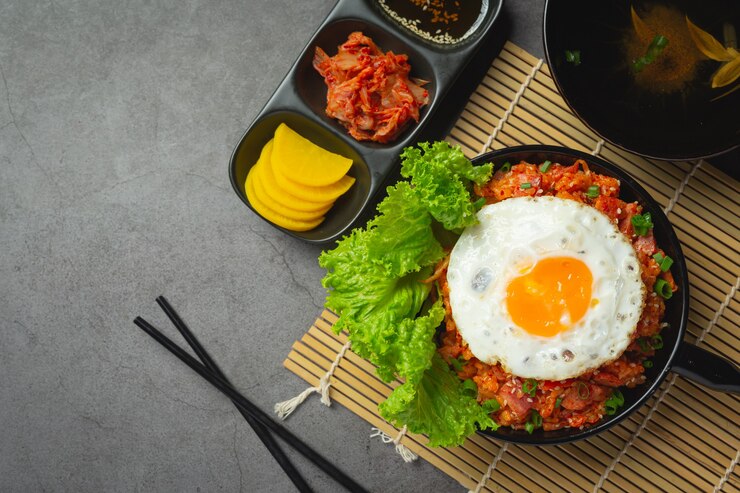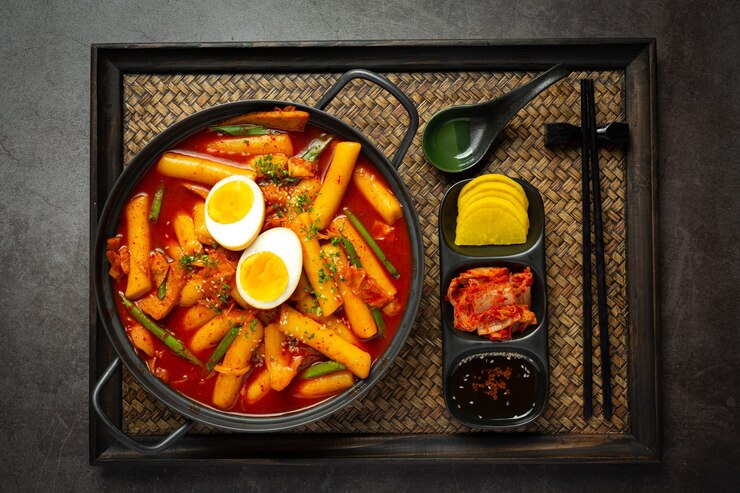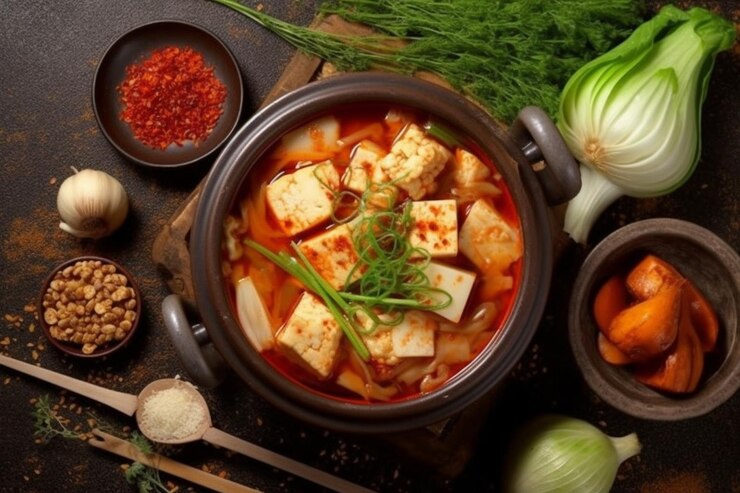
Table of Contents
Cooking the Best South Korean Secret Food Recipes in 2025: A Friendly Guide on South Korean Cuisine
Introduction
South Korean food is an amazing blend of strong flavors, fabulous traditions, and warm memories. And if you have ever enjoyed that invigorating warmth of tteokbokki or the refreshing crunch of kimchi, you know exactly what I’m talking about. But you do know there are other not-so-well-known recipes and secrets that elevate these recipes? Let’s walk you through the best South Korean recipes of old favorites and some lesser-knowns and how to master those in your own home for 2025.
Take your apron because, honestly, this is fun and flavourful and absolutely going to be delish!
The Core of Korean Cooking is all about balance.
All of which brings us to balance.
- Spicy against sweet: tteokbokki-that hot chili paste alongside the sugar sweetness of rice cakes
- Crunch against soft: it is all crispy on the outside, yet soft to be as soft as possible on the inside: kimchi jeon
- Jarring flavors against subtle: deep spicy sundubu jjigae tempered by the creaminess of tofu.
Therein lies the beauty – all those opposites combine to form a tasty, beautiful dish. Now, let’s cook!

Essential South Korean Recipes
Kimchi (김치): Korea’s Soul
Kimchi is a fermented vegetable dish. It is most often prepared using napa cabbage or radishes. Preparing kimchi at home might be quite a time-consuming process, but that makes it very rewarding.
Ingredients:
- 1 large napa cabbage
- 1 cup Korean coarse sea salt
- 5 cups water
- 1 cup Korean red chili flakes (gochugaru)
- 1/2 cup fish sauce or soy sauce (for vegetarians)
- 1/4 cup minced garlic
- 2 tbsp grated ginger
- 1 tbsp sugar
- 1 small daikon radish, julienned
- 4 green onions, chopped
Steps:
- Cut the cabbage into quarters and soak it in salted water for 2-3 hours, until softened.
- Rinse well and drain.
- Mix chili flakes, fish sauce, garlic, ginger, sugar, and water to a paste.
- Add in the julienned radish and green onions and then smear that mixture on the cabbage evenly.
- Keep in an airtight container at room temperature for 1-2 days and refrigerate after that.
- Serve with rice, noodles, or as a burger top.
Pro Tip: Make small batches of your kimchi until you have your spice-salt combination down.

Bibimbap (비빔밥): The Ultimate One-Bowl Wonder
Ingredients:
- 2 cups cooked white rice
- 1/2 cup seasoned spinach (sigeumchi namul)
- 1/2 cup sautéed zucchini strips
- 1/2 cup bean sprouts (kongnamul)
- 1/2 cup bulgogi (recipe below!)
- 1 fried egg (sunny side up)
- 2 tbsp gochujang (red chili paste)
Steps:
- Put rice in a big bowl. Put vegetables, beef, and egg on top like an artist painting a canvas.
- Add a dollop of gochujang in the center.
- Mix everything together before eating. The messier it looks, the better it tastes!
Pro Tip: Serve in a hot stone bowl (dolsot bibimbap) for crispy rice at the bottom.

Tteokbokki (떡볶이): The Comfort Food
Tteokbokki is like a warm hug after a long day. These chewy rice cakes swim in a spicy, slightly sweet sauce.
Ingredients
- 1 lb Korean rice cakes (tteok)
- 2 cups water
- 3 tbsp gochujang
- 1 tbsp gochugaru (optional for extra heat)
- 2 tbsp soy sauce
- 1 tbsp sugar
- 2 boiled eggs (optional)
- Green onions and sesame seeds for garnish
Steps
- Boil water, add gochujang, gochugaru, soy sauce, and sugar. Stir well.
- Add rice cakes and simmer until soft and the sauce thickens (about 10 minutes).
- Serve hot with boiled eggs, garnished with green onions and sesame seeds.
Pro Tip: Add fish cakes or mozzarella cheese for extra flavor.

Hidden Gems: Less Common Korean Recipes
Sundubu Jjigae (순두부찌개): Silky Soft Tofu Stew
Ingredients:
- 1 package soft tofu (sundubu)
- 1 cup anchovy stock (or vegetable stock)
- 1 tbsp sesame oil
- 2 garlic cloves, minced
- 2 tbsp gochugaru
- 1/4 cup kimchi
- 1 egg
Steps:
- Heat sesame oil in a pot. Add garlic and gochugaru. Saute until fragrant.
- Add stock, kimchi, and soft tofu. Simmer gently for 10 minutes.
- Crack an egg into the pot just before serving.
Pro Tip: Sundubu jjigae pairs beautifully with steamed rice and pickled sides.

Haemul Pajeon (해물파전): Crispy Seafood Pancake
Ingredients:
- 1 cup all-purpose flour
- ½ cup water
- 1 egg
- ½ cup seafood mix (shrimp, squid, etc.)
- ½ cup chopped green onions
- Soy-vinegar dipping sauce
Steps:
- Mix flour, water, and egg to a batter. Fold in seafood and green onions.
- Pour the batter into a very hot greased skillet. Fry until both sides are crispy.
- Serve with a simple dipping sauce made of soy sauce and vinegar.

Gamjatang (감자탕): Hearty Pork Bone Soup
Gamjatang is a warm comfort food with pork bones and potatoes in it, paired with earthy spices; the perfect comfort for cold nights.
Ingredients
- 2 lbs pork neck bones
- 1 tbsp Korean soybean paste (doenjang)
- 2 tbsp Korean red pepper paste (gochujang)
- 1 tbsp garlic
- 3-4 small potatoes
- Green onions, perilla leaves, and sesame seeds for garnish
Steps:
- Boil pork bones for 10 minutes. Drain and rinse to remove impurities.
- Put the clean bones into a pot with 8 cups of water, doenjang, and garlic and boil it over low flame for 2 hours.
- Add potatoes and continue to cook until the potatoes are soft. Garnish and serve.

2025: Secrets to Korean Cooking
- Stock Up on Essentials: Pantry staples are gochujang, doenjang, sesame oil, and dried anchovies.
- Fresh is the emphasis: Koreans are very big on fresh veggies, so use whatever’s seasonal whenever possible.
- Adjust the Heat: Not everybody has a taste for spicy food, so begin with chili paste. Gradually increase
_____________________________________
Learn More about Korean Cuisine
The journey into Korean food is not so much a series of recipes. Instead, there lies an entire universe of regional foods, unknown delicacies, and fusion foods waiting to be explored. Let’s take it a bit further into some culinary gems and techniques that will take your cooking up another notch entirely.
_____________________________________
The Magic of Korean Side Dishes (Banchan)
One of the most exciting things about Korean food is the banchan, or side dishes, served with every meal. These small plates bring diversity to the table and allow you to experience multiple flavors in one sitting.
Popular Banchan to Try at Home:
Kongnamul Muchim (Seasoned Bean Sprouts):
Toss blanched bean sprouts with sesame oil, soy sauce, minced garlic, and sesame seeds. This simple yet flavorful dish complements any main course.
Oi Muchim (Spicy Cucumber Salad)
Slice cucumbers thinly and toss with gochugaru, sesame oil, garlic, and a pinch of vinegar for a refreshing tang.
Japchae (Glass Noodle Stir-Fry)
Stir-fried sweet potato noodles mixed with an assortment of vegetables and seasoned with soy-sesame seasoning
Dashima Guk (Seaweed Soup)
Light and healthy, this soup goes well with heavier meals. It is also served on birthdays in Korea.
Learn More about Korean Cuisine
The journey into Korean food is not so much a series of recipes. Instead, there lies an entire universe of regional foods, unknown delicacies, and fusion foods waiting to be explored. Let’s take it a bit further into some culinary gems and techniques that will take your cooking up another notch entirely.
_____________________________________
The Magic of Korean Side Dishes (Banchan)
One of the most exciting things about Korean food is the banchan, or side dishes, served with every meal. These small plates bring diversity to the table and allow you to experience multiple flavors in one sitting.
Popular Banchan to Try at Home:
Kongnamul Muchim (Seasoned Bean Sprouts):
Toss blanched bean sprouts with sesame oil, soy sauce, minced garlic, and sesame seeds. This simple yet flavorful dish complements any main course.
Oi Muchim (Spicy Cucumber Salad)
Slice cucumbers thinly and toss with gochugaru, sesame oil, garlic, and a pinch of vinegar for a refreshing tang.
Japchae (Glass Noodle Stir-Fry)
Stir-fried sweet potato noodles mixed with an assortment of vegetables, and seasoned with soy-sesame seasoning
Dashima Guk (Seaweed Soup)
Light and healthy, this soup goes well with heavier meals. It is also served on birthdays in Korea.
Special Techniques to Master the Art of Korean Cooking
To elevate your Korean cooking to the next level, get to understand these basic techniques:
Fermentation:
- Kimchi and doenjang are prepared through fermentation, which yields deep flavors. Though time consuming, it’s so worth the wait.
- Try small batches and remember to sterilize jars to avoid contamination.
Marination:
- Marinating meat is a basic process in the preparation of bulgogi and galbi. Soy sauce, sugar, garlic, sesame oil, and fruit juice (such as pear or apple) have to be mixed to soften and flavor the meat.
- Let the meat marinate overnight for best results.
Stir-Frying at High Heat:
- Korean stir-frying involves cooking very quickly over high heat in order to preserve nutrients and flavors. Use a heavy skillet or wok to distribute the heat evenly.
Stoneware Cooking:
- Many traditional Korean foods, such as dolsot bibimbap and samgyetang (ginseng chicken soup), are cooked in stone pots. These good retainers of heat make food better textured and more flavorful.

A Glimpse into Provincial Korean Foods
Food in Korea differs greatly from one province to another, with different ingredients and preparation. Here’s a very quick overview:
Jeolla Province
Renowned as Korea’s gastronomic capital, this province serves some pretty elaborate dishes, among them jeonju bibimbap and fresh seafood stews.
Gyeongsang Province
Famous for its bold flavors, dishes like andong jjimdak (braised chicken) and daegu makchang (grilled intestines) come from here.
Jeju Island
Jeju is fresh seafood and black pork. Don’t miss jeonbokjuk (abalone porridge) if you ever visit.
Gangwon Province
Mountainous regions here offer rustic dishes like makguksu (buckwheat noodles) and gamja jeon (potato pancakes).
Fusion Alert: Korean Recipes with a Twist
Modern Korean food picks up fusion cooking by presenting delectable new dishes from worldwide influence with the traditional core essence of the cuisines. You can try these for examples:
Kimchi Pizza
Spread a thin layer of gochujang over the pizza dough, top with mozzarella cheese, kimchi, and sliced scallions. Bake it to crispiness for the right amount of spiciness and tanginess.
Korean Tacos
Bulgogi or spicy pork as the filling for a taco, topped with kimchi slaw and finished with a drizzle of sesame-lime crema to make it unforgettable.
Bulgogi Sliders
Marinated beef patties topped with a dollop of gochujang mayo, lettuce, and pickled radish served on mini buns.
Ramen Carbonara
Instant Korean ramen mixed with creamy egg yolk and cheese sauce and finished with crispy bacon or mushrooms for a rich, decadent dish.
Incorporate Korean Food into your Daily Routine
Cooking Korean food at home does not necessarily have to be a rare thing. In fact, it can be done regularly by slight modifications:
Prepare Kimchi in bulk
You will have your kimchi in the refrigerator and ready to use as flavor for rice, noodles, and even grilled cheese sandwiches.
Soup Sunday
Designate one day a week for soups like doenjang jjigae or sundubu jjigae. They are filling, healthy, and can be reheated easily.
Rice Cooker Magic
Use your rice cooker for plain rice but also use it for bibimbap or flavored rice with soy sauce and veggies.
One-Pot Korean Dinners
Dishes like dakdoritang (spicy chicken stew) or budae jjigae (army stew) are easy and require less cleanup.

More Korean Cooking Resources
If you are willing to go deeper into Korean dishes, here are some good sources for you to explore
YouTube Channels:
- Maangchi: an absolute treasure trove of authentic Korean recipes explained in a fun and approachable way.
- Korean Bapsang: best for in-depth traditional recipe preparation
Cookbooks
- Korean Home Cooking by Sohui Kim
- My Korea by Hooni Kim
Online Communities:
Join Korean cooking communities on forums or social media groups, share your tips and tricks, and some pictures of your creations.
Conclusion: Bring the Flavors of Korea to Your Kitchen
South Korean cuisine is a true treasure trove of flavors, textures, and techniques, blending the bold and the subtle into every dish. Whether you’re savoring the spicy kick of tteokbokki, the balanced harmony of bibimbap, or the comforting warmth of sundubu jjigae, Korean food has something for every palate.
It’s about being able to taste and enjoy the heart and culture of Korea from the comfort of your own kitchen. Not following a set of step-by-step directions but experimenting, tasting, and sharing meals that bring people together.
Feel free to leave a comment with questions or share your Korean food journey. Let’s connect and keep the love for Korean cuisine alive!
FAQs: Your Korean Cooking Questions Answered
- What if I don’t have a Korean store around me to buy ingredients?
You can buy Korean ingredients at H Mart, Amazon, or speciality Korean markets that ship nationwide. Many modern grocery stores now carry essentials like gochujang, sesame oil, and kimchi.
______________________________________
- How do I reduce the spiciness of Korean recipes?
Yes! Remove or use less amount of gochugaru (Korean chili flakes) and gochujang (chili paste). Use these alternatives with soy sauce or miso paste for that deeper flavor but less spicy.
________________________________________
- How long does homemade kimchi keep?
Homemade kimchi keeps for several months when kept in an airtight container in the fridge. The fermentation process will not cease, and it becomes increasingly strong in flavor.
________________________________________
- Can I use regular soy sauce instead of Korean soy sauce?
Yes, but note that Korean soy sauce (ganjang) has a lighter flavor. Regular soy sauce works in most dishes, but adjust the amount to avoid overpowering the dish.
________________________________________
- Are there vegan substitutes for fish sauce in Korean recipes?
Yes! Use soy sauce, miso paste, or a combination of soy sauce and seaweed broth for a vegan substitute for fish sauce.
________________________________________
- What’s the easiest Korean dish to start with?
Bibimbap is an excellent starter dish. It consists of basic stir-frying and layering ingredients over rice, and it’s so easy to make and versatile!
________________________________________
- Can I freeze leftover kimchi?
Freezing kimchi is not recommended since the freezing process alters the texture and flavor. However, overfermented kimchi can be utilized in recipes such as kimchi jjigae (stew) or kimchi fried rice.
________________________________________
- How do I make tteokbokki rice cakes soft again if they are hard?
Let soaked hard rice cakes soak in warm water for 10–15 minutes before cooking. This will help them soften and become ready to absorb flavors.
____________________________________
- Do I need a stone pot (dolsot) to make bibimbap?
No, you can use a plain skillet or bowl. But using a hot stone pot creates the crispy rice layer (nurungji) that’s a hallmark of dolsot bibimbap.
_____________________________________
- Must I use MSG in Korean cooking?
You can! Actually, most Korean dishes extract umami from natural components like doenjang (a paste made from fermented soybean paste), seaweed, or anchovy stock.
____________________________________
- What alternatives to Korean pear are there for marinade bulgogi?
You can have grated apples, regular pears, or even Kiwi fruits. The fruits tenderize the meat and add sweet flavors to the food.
___________________________________________________
- What is the typical equipment for Korean cooking?
- Clay rice bowl (dolsot): Rice and soups in these vessels become crisper
- Metal chopsticks: Chopsticks when having Korean food
- Mandoline slicer: Radishes and cucumbers that have slices so thin one layer
___________________________________________________
- Can any Korean food be made without containing gluten?
Absolutely! Soye should be made from gluten-free soy, rice flour substitute wheat flour, and new products like gochujang are certified gluten-free
________________________________________
- What is the difference between doenjang jjigae and sundubu jjigae?
Doenjang jjigae is a fermented soybean paste-based stew often containing firm tofu, vegetables, and anchovy stock. Sundubu jjigae is a spicier stew made with soft tofu and gochugaru.
________________________________________
- Are Korean pancakes (jeon) always savory?
Mostly, yes. However, there are sweet versions like hotteok (stuffed sweet pancakes) filled with brown sugar, nuts, and cinnamon.
________________________________________
- What’s the key to soft, fluffy steamed rice?
Several waterings help remove excess starch from the rice. Cooking is best accomplished by a steamer or rice cooker for consistency. However, there will be a good result on the stovetop; just take the 1:1.25 liquid ratio for rice/water.
________________________________________
- How do I store the unused gochujang and doenjang?
Keep these fermented pastes cold in a tightly sealed fridge. They can last quite a while—months if you don’t, and indeed years.
________________________________________
- Do I truly need to use anchovy stock in soups?
Yes, you can omit it or use vegetable stock or dried kelp broth instead. Anchovy stock does add depth, but it is not necessary to include it in every soup.
____________________________________
- What’s an easy Korean dessert to make?
Hotteok (sweet pancakes) or bingsu (shaved ice dessert with toppings)—easy, delicious.
____________________________________
- How do I recreate the smoky flavor that is associated with Korean BBQ at home?
Grill on a portable tabletop or cast-iron skillet with high heat. Anything marinated with sesame oil or sugar that caramelizes works well for that smoky flavor from Korean BBQ.
_____
Got any other questions? Throw them in the comments below, and let’s keep the conversation going! Happy cooking!
Final Thoughts
Korean cuisine must be something so much more than the mere food itself; rather it should be a form of celebration for life, culture, and being together in togetherness for each dish that warmly invites you to take a little time out and enjoy the moment.
Whether you are a pro or just starting, these recipes and tips will bring authentic South Korean flavors into your home. Remember, the best dishes aren’t just made of the finest ingredients but also love and enthusiasm.
So, roll up your sleeves and give these recipes a go. You might just find that new favorite comfort food. As they say in Korea, 맛있게 드세요! (masitge deuseyo) —Enjoy your meal!




